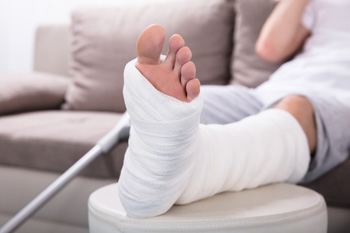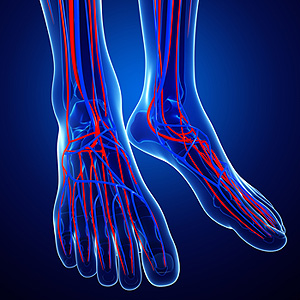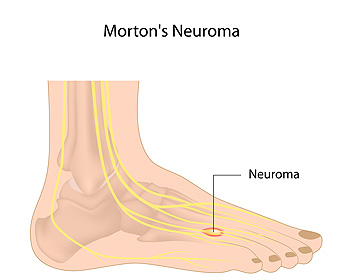Blog
Foot Pain and Walking
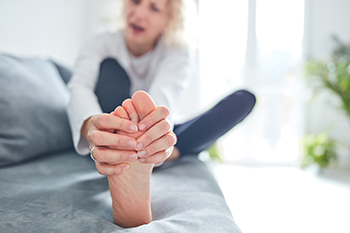 Foot pain may become worse while walking. Many patients experience occasional aches and pains in their feet, and chronic pain may indicate serious or underlying foot conditions. Pain in the heel may represent plantar fasciitis, which is an inflammation of the plantar fascia. This is the portion of tissue that connects the heel to the toes, and may feel worse upon arising in the morning. A condition that affects the nerves in the foot may indicate Morton’s neuroma, and the pain is often felt in the ball of the foot. In severe cases, it may gravitate to the toes, which can cause the entire foot to feel uncomfortable. There are several types of tendinitis that can cause severe pain. When the Achilles tendon is affected, the heel and calf are targeted. Extensor tendonitis can cause the top of the foot pain and discomfort, and the outside and back of the foot can be affected by peroneal tendonitis. Any type of foot pain warrants a visit to the podiatrist, who can properly diagnose and treat painful foot conditions.
Foot pain may become worse while walking. Many patients experience occasional aches and pains in their feet, and chronic pain may indicate serious or underlying foot conditions. Pain in the heel may represent plantar fasciitis, which is an inflammation of the plantar fascia. This is the portion of tissue that connects the heel to the toes, and may feel worse upon arising in the morning. A condition that affects the nerves in the foot may indicate Morton’s neuroma, and the pain is often felt in the ball of the foot. In severe cases, it may gravitate to the toes, which can cause the entire foot to feel uncomfortable. There are several types of tendinitis that can cause severe pain. When the Achilles tendon is affected, the heel and calf are targeted. Extensor tendonitis can cause the top of the foot pain and discomfort, and the outside and back of the foot can be affected by peroneal tendonitis. Any type of foot pain warrants a visit to the podiatrist, who can properly diagnose and treat painful foot conditions.
Foot Pain
Foot pain can be extremely painful and debilitating. If you have a foot pain, consult with one of our podiatrists from James Kutchback, DPM, CWS-P. Our doctors will assess your condition and provide you with quality foot and ankle treatment.
Causes
Foot pain is a very broad condition that could be caused by one or more ailments. The most common include:
- Bunions
- Hammertoes
- Plantar Fasciitis
- Bone Spurs
- Corns
- Tarsal Tunnel Syndrome
- Ingrown Toenails
- Arthritis (such as Gout, Rheumatoid, and Osteoarthritis)
- Flat Feet
- Injury (from stress fractures, broken toe, foot, ankle, Achilles tendon ruptures, and sprains)
- And more
Diagnosis
To figure out the cause of foot pain, podiatrists utilize several different methods. This can range from simple visual inspections and sensation tests to X-rays and MRI scans. Prior medical history, family medical history, and any recent physical traumatic events will all be taken into consideration for a proper diagnosis.
Treatment
Treatment depends upon the cause of the foot pain. Whether it is resting, staying off the foot, or having surgery; podiatrists have a number of treatment options available for foot pain.
If you have any questions, please feel free to contact our offices located in The Woodlands and Woodville, TX . We offer the newest diagnostic and treatment technologies for all your foot care needs.
Signs of a Broken Foot
A foot fracture occurs when one or more of the bones in the foot breaks. This is often due to either a sudden injury or small, repetitive stress injuries to the bones over time. Signs of a broken foot bone include pain that increases upon standing or walking, tenderness, swelling, bruising, numbness, a cracking sound when moving the foot, and an abnormal foot shape. In very severe, open fractures, bits of broken bone may break through the skin and require emergency care. If you suspect that you have broken a bone in your foot, it is strongly suggested that you seek the care of a podiatrist. The podiatrist will be able to diagnose the fracture, determine the extent of the injury, and offer treatments to help you fully recover.
A broken foot requires immediate medical attention and treatment. If you need your feet checked, contact one of our podiatrists from James Kutchback, DPM, CWS-P. Our doctors can provide the care you need to keep you pain-free and on your feet.
Broken Foot Causes, Symptoms, and Treatment
A broken foot is caused by one of the bones in the foot typically breaking when bended, crushed, or stretched beyond its natural capabilities. Usually the location of the fracture indicates how the break occurred, whether it was through an object, fall, or any other type of injury.
Common Symptoms of Broken Feet:
- Bruising
- Pain
- Redness
- Swelling
- Blue in color
- Numbness
- Cold
- Misshapen
- Cuts
- Deformities
Those that suspect they have a broken foot shoot seek urgent medical attention where a medical professional could diagnose the severity.
Treatment for broken bones varies depending on the cause, severity and location. Some will require the use of splints, casts or crutches while others could even involve surgery to repair the broken bones. Personal care includes the use of ice and keeping the foot stabilized and elevated.
If you have any questions, please feel free to contact our offices located in The Woodlands and Woodville, TX . We offer the newest diagnostic and treatment technologies for all your foot care needs.
Am I More Likely to Develop Toenail Fungus?
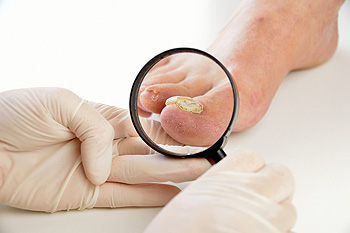 A fungal toenail infection is a common problem caused by fungi growing in and around your toenails. This condition can change the appearance of toenails making them brittle, thickened, crumbly, or discolored. In more severe cases, the toenail may separate from the nail bed causing pain, a foul odor, and an increased risk of infection. Some people are more at risk for developing a toenail infection than others. People with other medical conditions like diabetes, peripheral artery disease, peripheral neuropathy, or a compromised immune system, are more likely to incur an infection. Previous injury or prior deformities of the toenails can also increase risk. Wearing shoes and socks that prevent air from reaching your feet, having skin that is moist for prolonged periods of time (often due to excessive sweating), and walking barefoot in warm, moist, or public places, like swimming pools and locker rooms, should be avoided. If you are suffering from any kind of toenail fungus please seek the care of a podiatrist.
A fungal toenail infection is a common problem caused by fungi growing in and around your toenails. This condition can change the appearance of toenails making them brittle, thickened, crumbly, or discolored. In more severe cases, the toenail may separate from the nail bed causing pain, a foul odor, and an increased risk of infection. Some people are more at risk for developing a toenail infection than others. People with other medical conditions like diabetes, peripheral artery disease, peripheral neuropathy, or a compromised immune system, are more likely to incur an infection. Previous injury or prior deformities of the toenails can also increase risk. Wearing shoes and socks that prevent air from reaching your feet, having skin that is moist for prolonged periods of time (often due to excessive sweating), and walking barefoot in warm, moist, or public places, like swimming pools and locker rooms, should be avoided. If you are suffering from any kind of toenail fungus please seek the care of a podiatrist.
If left untreated, toenail fungus may spread to other toenails, skin, or even fingernails. If you suspect you have toenail fungus it is important to seek treatment right away. For more information about treatment, contact one of our podiatrists of James Kutchback, DPM, CWS-P. Our doctors can provide the care you need to keep you pain-free and on your feet.
Symptoms
- Warped or oddly shaped nails
- Yellowish nails
- Loose/separated nail
- Buildup of bits and pieces of nail fragments under the nail
- Brittle, broken, thickened nail
Treatment
If self-care strategies and over-the-counter medications does not help your fungus, your podiatrist may give you a prescription drug instead. Even if you find relief from your toenail fungus symptoms, you may experience a repeat infection in the future.
Prevention
In order to prevent getting toenail fungus in the future, you should always make sure to wash your feet with soap and water. After washing, it is important to dry your feet thoroughly especially in between the toes. When trimming your toenails, be sure to trim straight across instead of in a rounded shape. It is crucial not to cover up discolored nails with nail polish because that will prevent your nail from being able to “breathe”.
In some cases, surgical procedure may be needed to remove the toenail fungus. Consult with your podiatrist about the best treatment options for your case of toenail fungus.
If you have any questions please contact our offices located in The Woodlands and Woodville, TX . We offer the newest diagnostic and treatment technologies for all your foot and ankle needs.
Ankle-Brachial Index and PAD
The ankle-brachial index test is a relatively quick, painless, and non-invasive screening measure used to test for the presence of peripheral artery disease (PAD). PAD is a condition in which circulation in the lower limbs is reduced, typically due to a buildup of plaque in the arteries that can cause them to narrow and harden, thereby impeding blood flow. Symptoms of PAD may include leg cramps, numbness, muscle weakness, and difficulty walking, but in its earlier stages, this condition is often asymptomatic. For this reason, it is important to get tested for PAD. People who are older and those who have a history of cardiovascular disease are especially at risk and can be tested by their podiatrist. During the ankle-brachial index test, the podiatrist measures the blood pressure at the upper arm and at the ankle, comparing the resulting numbers to form a ratio that predicts the likelihood of you having PAD. A high ankle-brachial index score can predict not only PAD, but also cardiovascular events, such as a heart attack or stroke. If you are at risk of PAD or are experiencing any symptoms, talk to your podiatrist about vascular testing today.
Vascular testing plays an important part in diagnosing disease like peripheral artery disease. If you have symptoms of peripheral artery disease, or diabetes, consult with one of our podiatrists from James Kutchback, DPM, CWS-P. Our doctors will assess your condition and provide you with quality foot and ankle treatment.
What Is Vascular Testing?
Vascular testing checks for how well blood circulation is in the veins and arteries. This is most often done to determine and treat a patient for peripheral artery disease (PAD), stroke, and aneurysms. Podiatrists utilize vascular testing when a patient has symptoms of PAD or if they believe they might. If a patient has diabetes, a podiatrist may determine a vascular test to be prudent to check for poor blood circulation.
How Is it Conducted?
Most forms of vascular testing are non-invasive. Podiatrists will first conduct a visual inspection for any wounds, discoloration, and any abnormal signs prior to a vascular test.
The most common tests include:
- Ankle-Brachial Index (ABI) examination
- Doppler examination
- Pedal pulses
These tests are safe, painless, and easy to do. Once finished, the podiatrist can then provide a diagnosis and the best course for treatment.
If you have any questions please contact our offices located in The Woodlands and Woodville, TX . We offer the newest diagnostic and treatment technologies for all your foot and ankle needs.
Signs of Cuboid Syndrome
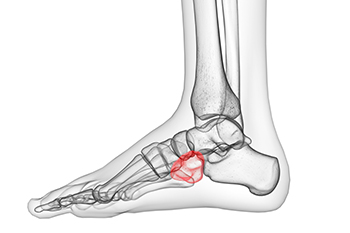 The cuboid is a cube-shaped bone located in the middle of your foot. This bone can become injured or dislocated following an injury to the foot. People who play sports that put a lot of stress on the feet and people with notable overpronation of the feet are said to have an increased risk for developing this condition. The most common symptom of cuboid syndrome is pain and weakness in the affected foot, particularly when bearing weight. The foot may also be swollen, tender, or red. These symptoms can be severe enough to make walking or standing difficult, sometimes causing a limp, and interfering with daily activities. Symptoms can also have a sudden or gradual onset. If your foot is showing any signs or symptoms of cuboid syndrome, it is suggested that you consult with a podiatrist as soon as possible.
The cuboid is a cube-shaped bone located in the middle of your foot. This bone can become injured or dislocated following an injury to the foot. People who play sports that put a lot of stress on the feet and people with notable overpronation of the feet are said to have an increased risk for developing this condition. The most common symptom of cuboid syndrome is pain and weakness in the affected foot, particularly when bearing weight. The foot may also be swollen, tender, or red. These symptoms can be severe enough to make walking or standing difficult, sometimes causing a limp, and interfering with daily activities. Symptoms can also have a sudden or gradual onset. If your foot is showing any signs or symptoms of cuboid syndrome, it is suggested that you consult with a podiatrist as soon as possible.
Cuboid syndrome, also known as cuboid subluxation, occurs when the joints and ligaments near the cuboid bone in the foot become torn. If you have cuboid syndrome, consult with one of our podiatrists from James Kutchback, DPM, CWS-P. Our doctors will assess your condition and provide you with quality foot and ankle treatment.
Cuboid syndrome is a common cause of lateral foot pain, which is pain on the outside of the foot. The condition may happen suddenly due to an ankle sprain, or it may develop slowly overtime from repetitive tension through the bone and surrounding structures.
Causes
The most common causes of cuboid syndrome include:
- Injury – The most common cause of this ailment is an ankle sprain.
- Repetitive Strain – Tension placed through the peroneus longus muscle from repetitive activities such as jumping and running may cause excessive traction on the bone causing it to sublux.
- Altered Foot Biomechanics – Most people suffering from cuboid subluxation have flat feet.
Symptoms
A common symptom of cuboid syndrome is pain along the outside of the foot which can be felt in the ankle and toes. This pain may create walking difficulties and may cause those with the condition to walk with a limp.
Diagnosis
Diagnosis of cuboid syndrome is often difficult, and it is often misdiagnosed. X-rays, MRIs and CT scans often fail to properly show the cuboid subluxation. Although there isn’t a specific test used to diagnose cuboid syndrome, your podiatrist will usually check if pain is felt while pressing firmly on the cuboid bone of your foot.
Treatment
Just as the range of causes varies widely, so do treatments. Some more common treatments are ice therapy, rest, exercise, taping, and orthotics.
If you have any questions, please feel free to contact our offices located in The Woodlands and Woodville, TX . We offer the newest diagnostic and treatment technologies for all your foot care needs.
Understanding Morton’s Neuroma
A neuroma is a condition where the tissue that surrounds a nerve becomes thickened and inflamed. A neuroma can materialize around any nerve of the body, but when it occurs between the 3rd and 4th toes (or less commonly the 2nd and 3rd toes), it is known as Morton’s Neuroma. This benign growth of nerve cells can cause tingling, pain, and numbness in the ball of the foot—often making it feel as if there is a pebble stuck in your shoe. It is suggested that you see a podiatrist if you suspect you have Mortaon’s neuroma, as the condition may worsen and possibly lead to permanent nerve damage.
Morton’s neuroma is a very uncomfortable condition to live with. If you think you have Morton’s neuroma, contact one of our podiatrists of James Kutchback, DPM, CWS-P. Our doctors will attend to all of your foot care needs and answer any of your related questions.
Morton’s Neuroma
Morton's neuroma is a painful foot condition that commonly affects the areas between the second and third or third and fourth toe, although other areas of the foot are also susceptible. Morton’s neuroma is caused by an inflamed nerve in the foot that is being squeezed and aggravated by surrounding bones.
What Increases the Chances of Having Morton’s Neuroma?
- Ill-fitting high heels or shoes that add pressure to the toe or foot
- Jogging, running or any sport that involves constant impact to the foot
- Flat feet, bunions, and any other foot deformities
Morton’s neuroma is a very treatable condition. Orthotics and shoe inserts can often be used to alleviate the pain on the forefront of the feet. In more severe cases, corticosteroids can also be prescribed. In order to figure out the best treatment for your neuroma, it’s recommended to seek the care of a podiatrist who can diagnose your condition and provide different treatment options.
If you have any questions, please feel free to contact our offices located in The Woodlands and Woodville, TX . We offer the newest diagnostic and treatment technologies for all your foot care needs.
Should I Treat My Bunions?
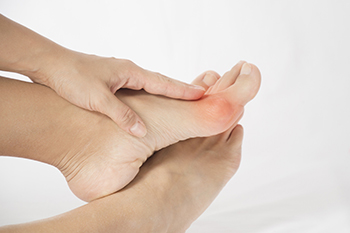 Bunions are bony growths that appear on the outer side of the foot at the base of the big toe joint. This is a deformity that may cause pain, swelling, redness, and difficulty wearing shoes and while walking. When left untreated, bunions tend to progressively worsen over time. As a bunion grows, it pushes the big toe towards the smaller toes, changing the shape of the foot in the process. The misaligned big toe may then push the second toe out of alignment. Bunions can also lead to arthritis in the big toe joints. Bunions can be managed and their progression can be slowed through a variety of conservative treatments, such as footwear modifications. Surgery may also be an option and can permanently correct a bunion. If you suffer from bunions, it is suggested that you see a podiatrist for treatment.
Bunions are bony growths that appear on the outer side of the foot at the base of the big toe joint. This is a deformity that may cause pain, swelling, redness, and difficulty wearing shoes and while walking. When left untreated, bunions tend to progressively worsen over time. As a bunion grows, it pushes the big toe towards the smaller toes, changing the shape of the foot in the process. The misaligned big toe may then push the second toe out of alignment. Bunions can also lead to arthritis in the big toe joints. Bunions can be managed and their progression can be slowed through a variety of conservative treatments, such as footwear modifications. Surgery may also be an option and can permanently correct a bunion. If you suffer from bunions, it is suggested that you see a podiatrist for treatment.
If you are suffering from bunions, contact one of our podiatrists of James Kutchback, DPM, CWS-P. Our doctors can provide the care you need to keep you pain-free and on your feet.
What Is a Bunion?
A bunion is formed of swollen tissue or an enlargement of boney growth, usually located at the base joint of the toe that connects to the foot. The swelling occurs due to the bones in the big toe shifting inward, which impacts the other toes of the foot. This causes the area around the base of the big toe to become inflamed and painful.
Why Do Bunions Form?
Genetics – Susceptibility to bunions are often hereditary
Stress on the feet – Poorly fitted and uncomfortable footwear that places stress on feet, such as heels, can worsen existing bunions
How Are Bunions Diagnosed?
Doctors often perform two tests – blood tests and x-rays – when trying to diagnose bunions, especially in the early stages of development. Blood tests help determine if the foot pain is being caused by something else, such as arthritis, while x-rays provide a clear picture of your bone structure to your doctor.
How Are Bunions Treated?
- Refrain from wearing heels or similar shoes that cause discomfort
- Select wider shoes that can provide more comfort and reduce pain
- Anti-inflammatory and pain management drugs
- Orthotics or foot inserts
- Surgery
If you have any questions, please feel free to contact our offices located in The Woodlands and Woodville, TX . We offer the newest diagnostic and treatment technologies for all your foot care needs.
What Is a Metatarsal Fracture?
The metatarsals are five long, slim bones that run the length of the foot to the base of the toes. They are a common site of fractures. The fifth metatarsal bone, which is located on the outside of the foot and connects your pinky toe to the rest of the foot, is the most likely foot bone to be fractured due to an acute injury. Metatarsals can also be the site of stress fractures, which occur over time due to overuse. Like other fractures, metatarsal fractures may be open or closed. Open fractures refer to broken bones that break through the skin, while closed fractures are internal. Metatarsal fractures can also be displaced, where the bones have become misaligned, or nondisplaced. If you suspect that you may have broken a bone in your foot, it is suggested that you see a podiatrist as soon as possible.
A broken foot requires immediate medical attention and treatment. If you need your feet checked, contact one of our podiatrists from James Kutchback, DPM, CWS-P. Our doctors can provide the care you need to keep you pain-free and on your feet.
Broken Foot Causes, Symptoms, and Treatment
A broken foot is caused by one of the bones in the foot typically breaking when bended, crushed, or stretched beyond its natural capabilities. Usually the location of the fracture indicates how the break occurred, whether it was through an object, fall, or any other type of injury.
Common Symptoms of Broken Feet:
- Bruising
- Pain
- Redness
- Swelling
- Blue in color
- Numbness
- Cold
- Misshapen
- Cuts
- Deformities
Those that suspect they have a broken foot shoot seek urgent medical attention where a medical professional could diagnose the severity.
Treatment for broken bones varies depending on the cause, severity and location. Some will require the use of splints, casts or crutches while others could even involve surgery to repair the broken bones. Personal care includes the use of ice and keeping the foot stabilized and elevated.
If you have any questions, please feel free to contact our offices located in The Woodlands and Woodville, TX . We offer the newest diagnostic and treatment technologies for all your foot care needs.




